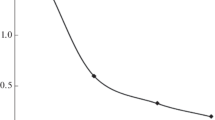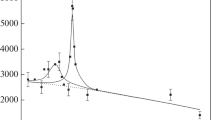Abstract
Theoretical analysis revealed that experimental results obtained in our studies on hypersound propagation in a guaiacol-glycerol solution in the vicinity of the closed phase-separation region, double critical point, and special point, as well as the origin of these regions, can be explained by the presence of two different phases (I and II) of the solution with phase-transition temperature T 0. Temperature T 0 coincides with the temperature at the center of closed phase-separation regions, as well as with the double critical point and with the special point. In (Frenkel) phase I, molecules are in potential wells whose depth exceeds the thermal energy of a molecule, while thermal energy in (gaslike) phase II is higher than the potential well depth. At the lower critical point, the thermodynamic potential of phase I is equal to the thermodynamic potential of the phase-separated solution. At the upper critical point, the thermodynamic potential of phase II is equal to the thermodynamic potential of the phase-separated solution. The observed broad dome of the hypersound absorption coefficient near T 0 can be explained by the contribution associated with fluctuations of the order parameter corresponding to the transition from phase I to phase II. The difference in the temperature coefficients of hypersound velocity on different sides of T 0 and some other effects are also explained.
Similar content being viewed by others
References
K. V. Kovalenko, S. V. Krivokhizha, I. L. Fabelinskiĭ, and L. L. Chaĭkov, Pis’ma Zh. Éksp. Teor. Fiz. 58, 395 (1993) [JETP Lett. 58, 404 (1993)].
K. V. Kovalenko, S. V. Krivokhizha, I. L. Fabelinskiĭ, and L. L. Chaĭkov, Kratk. Soobshch. Fiz., No.11, 19 (2002).
K. V. Kovalenko, S. V. Krivokhizha, and I. L. Fabelinskiĭ, Usp. Fiz. Nauk 166, 683 (1996) [Phys. Usp. 39, 635 (1996)].
K. V. Kovalenko, S. V. Krivokhizha, and L. L. Chaĭkov, Kratk. Soobshch. Fiz., No. 2, 40 (2001).
I. L. Fabelinskii, L. L. Chaikov, K. V. Kovalenko, and S. V. Krivokhizha, Lazer Phys. 1, 332 (2003).
H. Tanaka, Phys. Rev. E 62, 6968 (2000).
H. Tanaka, R. Kurita, and H. Mataki, Phys. Rev. Lett. 92, 025701 (2004).
R. Kurita and H. Tanaka, J. Phys.: Condens. Matter 17, 293 (2005).
S. V. Krivokhizha, I. A. Chaban, and L. L. Chaĭkov, Zh. Éksp. Teor. Fiz. 127, 623 (2005) [JETP 100, 550 (2005)].
M. A. Isakovich and I. A. Chaban, Zh. Éksp. Teor. Fiz. 50, 1343 (1966) [Sov. Phys. JETP 23, 893 (1966)].
K. V. Kovalenko and S. V. Krivokhizha, Kratk. Soobshch. Fiz., No. 3, 46 (2007).
I. A. Chaban, Akust. Zh. 21, 104 (1975) [Sov. Phys. Acoust. 21, 64 (1975)].
I. A. Chaban, Akust. Zh. 21, 286 (1975) [Sov. Phys. Acoust. 21, 177 (1975)].
Author information
Authors and Affiliations
Corresponding author
Additional information
Original Russian Text © K.V. Kovalenko, S.V. Krivokhizha, I.A. Chaban, L.L. Chaikov, 2008, published in Zhurnal Éksperimental’noĭ i Teoreticheskoĭ Fiziki, 2008, Vol. 133, No. 2, pp. 330–338.
Rights and permissions
About this article
Cite this article
Kovalenko, K.V., Krivokhizha, S.V., Chaban, I.A. et al. Detection of various phases in liquids from the hypersound velocity and damping near closed phase-separation regions of solutions. J. Exp. Theor. Phys. 106, 280–287 (2008). https://doi.org/10.1134/S1063776108020076
Received:
Published:
Issue Date:
DOI: https://doi.org/10.1134/S1063776108020076




